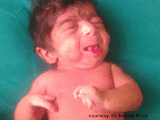MUTATION
I.Introduction
You want to know more about mutation? Lets find out!!
So mutation may affect only one gene or a whole chromosome.The errors in the sequence of DNA provide the variation that is fundamental to the evolution of species.
Kinds of Mutation
PATAU SYNDROME
Patau syndrome, also known as trisomy 13 and trisomy D, is a chromosomal abnormality, a syndrome in which a patient has an additional chromosome 13 due to a nondisjunction of chromosomes during meiosis Some are caused by Robertsonian translocation The extra chromosome 13 disrupts the normal course of development, causing heart and kidney defects, amongst other features characteristic of Patau syndrome. Like all nondisjuncton conditions (such as Down Syndrome and Edwards Syndrome), the risk of this syndrome in the offspring increases with maternal age at pregnancy, with about 31 years being the average. Patau syndrome affects somewhere between 1 in 10,000 and 1 in 21,700 live births.
PROGERIA SYNDROME
Progeria (also known as "Hutchinson–Gilford Progeria Syndrome","Hutchinson–Gilford syndrome", and "Progeria syndrome") is an extremely rare genetic condition wherein symptoms resembling aspects of aging are manifested at an early age. The word progeria comes from the Greek words "pro" , meaning "before", and "géras" , meaning "old age". The disorder has very low incidences and occurs in an estimated 1 per 8 million live births. Those born with progeria typically live to their mid teens and early twenties. It is a genetic condition that occurs as a new mutation (de novo), and is rarely inherited. Although the term progeria applies strictly speaking to all diseases characterized by premature aging symptoms, and is often used as such, it is often applied specifically in reference to Hutchinson-Gilford Progeria Syndrome (HGPS).
ALBINISM SYNDROME
Albinism (from LATIN albus, "white"; see extended etymology, also called achromia, achromasia, or achromatosis) is a congenital disorder characterized by the complete or partial absence of pigment in the skin, hair and eyes due to absence or defect of an enzyme involved in the production of melanin. Albinism results from inheritance of recessive gene alleles and is known to affect all vertebrates, including humans. While an organism with complete absence of melanin is called an albino , an organism with only a diminished amount of melanin is described as albinoid.
EDWARDS SYNDROME
Edwards syndrome (also known as Trisomy 18 (T18) or Trisomy E) is a genetic disorder caused by the presence of all or part of an extra 18th chromosome. It is named after John H. Edwards, who first described the syndrome in 1960. It is the second most common autosomal trisomy after Down syndrome, that carries to term.
Edwards syndrome is caused by the presence of three – as opposed to two – copies of chromosome 18 in a fetus's or infant's cells. Edwards' syndrome occurs in around one in 6,000 live births and around 80 per cent of those affected are female. The majority of fetuses with the syndrome die before birth. The incidence increases as the mother's age increases. The syndrome has a very low rate of survival, resulting from heart abnormalities, kidney malformations, and other internal organ disorders.
TURNER SYNDROME
Turner syndrome or Ullrich-Turner syndrome (also known as "Gonadal dysgenesis:550), 45 XO, encompasses several conditions in human females, of which monosomy X (absence of an entire sex chromosome, the Barr body) is most common. It is a chromosomal abnormality in which all or part of one of the sex chromosome is absent (unaffected humans have 46 chromosomes, of which two are sex chromosomes). Normal females have two X chromosomes, but in Turner syndrome, one of those sex chromosomes is missing or has other abnormalities. In some cases, the chromosome is missing in some cells but not others, a condition referred to as mosaicism or 'Turner mosaicism'.
II.Conclusion
On my own conclusion we have to be thankful that we are not like them that suffers that kind of syndrome we must take care ourselves,we don't know what happen next when your born again.













